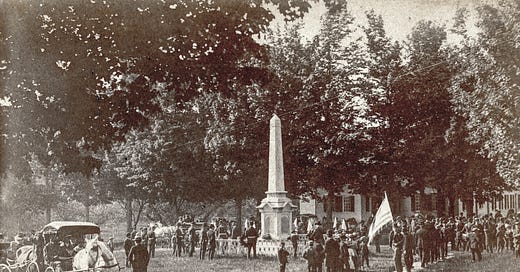Soldier’s Monument Dedication - Jun 17, 1878
Description of Monument
News clipping describing monument
The soldiers' monument is now erected, and is to be dedicated June 17th, 1878. Mr. Alex. McDonald, of Cambridge, Mass., was the contractor. The monument is of Mason granite, twenty-three feet in height, with a large base six feet square, on which is a smaller cap, bearing on the front the words, "Erected 1878." Above this is the die, four feet in height by three feet square, on the front of I which are the words, "New Ipswich- To the memory of her brave sons who died in the war of the rebellion." On the other three sides are the names of those who perished while in the army, numbering nineteen. Above the die is a larger cap projecting over, which is cut very tastefully, and on this rests the base of the shaft, which bears three stars on each side, and a star on each corner. The shaft is thirteen feet in length. On the front, in bold relief, are the stars and bars. The monument is to be enclosed by an appropriate fence, and the surroundings will be graded, thereby beautifying the vicinity.
Description of Dedication Ceremony
EDITORS NOTE:
History is detective work. We recently discovered additional information about the monument dedication. It was a lot more elaborate that the photo implies with speeches, a banquet and concert. We just found these news clippings. FYI a “collation” is defined as a light informal meal.
News Clipping 1
NEW IPSWICH, N. H., June 17. The dedication of the soldiers' monument took place here today in a blaze of glory. A large procession, consisting of military organizations, posts of the Grand Army, and fire companies of this and surrounding towns formed in line this morning on Main street and marched through the principal streets to the place where the monument was erected near the academy grounds. A salute was fired during the progress of the procession. Arrived on the spot addresses were made by the Hon. H. Eaton Barstow, president of the occasion, and General S. Y Griffin of Keene, orator of the day. After the dedicatory exercises procession was reformed and marched to a mammoth tent, where a sumptuous collation was served. In the evening a grand promenade concert was given by the Fitchburg band in Academy Hall.
News Clipping 2
NEW IPSWICH, N. H., June 17. The ceremony of the dedication of the soldiers' monument today attracted a very large crowd from the adjoining towns and villages. The weather was pleasant and the military display very imposing. The monument, bearing four tablets for inscriptions, is made of New Hampshire granite, quarried and designed at the granite works in Mason. The procession moved in the following order: Chief Marshal and aids, Peterboro' Cavalry; Fitchburg Band; Gov. Cheney Guards, Peterboro'; Lyndeboro Artillery; G. A. R. posts of Fitchburg, Nashua, Milford, Peterboro', New Ipswich and Greenville, together with the local fire companies.
The parade was through the principal streets, while cannon were fired from an adjoining height. The great crowd assembled at the grand stand near the monument in Academy square. After prayer by the Chaplain, Rev. Horace Parker, music by the band and an ode, Hon. Hosea Eaton of Boston, President of the day, with a befitting speech, introduced the orator, Gen. S. G. Griffin of Keene, who delivered a stirring and patriotic address.
After the exercises at the monument, the companies reformed and marched to a mammoth mammoth tent near the Congregational church, where a bountiful collation was served for all the invited guests.
New Ipswich nears anniversary
By JOHN ROSENFELDER
For the Ledger-Transcript (March 25, 2025)
Only a short part of the history of our section of the region that we call New Ipswich has been recorded.
Original inhabitants were attracted to the dense forests of white pine, chestnut and oak, flowing brooks and streams and abundant deer and salmon. The earliest visitors arrived in the 1730s, while Native Americans were still traveling through our region, but they left no evidence of a permanent settlement. The Town of New Ipswich was officially established in 1750, and what we see today bears the effects of those who settled here over the last 275 years.
The borders of New Ipswich changed several times during Colonial times, sometimes due to surveying or drafting errors. Finalized in 1741, the boundary between New Hampshire and Massachusetts “moved” New Ipswich from Massachusetts to New Hampshire. In 1737, proprietors of the recently established towns of Keene (1735) and Townsend, Mass., (1732) needed a connecting road. The most-direct route was through the future New Ipswich. A turnpike was built, opening the area to settlement.
Life in the mid-18th century was challenging, but settlers persisted.
Early farms were mostly subsistence affairs due to the rocky New Hampshire soil. The first church/meetinghouse was established near the old cemetery in 1760, with the Rev. Stephan Farrar as minister. The first of 14 schoolhouses was built in 1762. While some were Tories and supported the British, many residents were Patriots. The town even had a company of Minutemen, 98 of whom marched to Concord, Mass., to fight in the Battle of Bunker Hill.
New Ipswich became known for establishing the second academy in the state, New Ipswich Academy, later renamed Appleton Academy.
From 1789 to its closing in the late 1960s, it provided local residents an excellent education, which prepared them for a productive life and sent some graduates to Yale, Harvard and Dartmouth College.
In 1804, the first water-powered spinning mill in New Hampshire was built on the Souhegan River; later Brown’s Mill, and the mill at High Bridge were constructed. Energy available from the drop and flow of the Souhegan River allowed carding, wood-turning and grist and saw mills.
The town was taken up in the “Sheep Boom” of the 1820s, when much of the land was cleared for sheep pasture, and miles of stone walls were erected. Wool and later cotton mills prospered during the middle of the century, attracting French-Canadian immigrant workers. French
was spoken in many homes, and some residents attended the Catholic Church in Greenville. The Catholic cemetery on the town line has mostly French family headstones.
Another means of employment in New Ipswich was the processing of tobacco, grown further south.
Stephen Thayer operated a cigar and wooden match factory in Center Village, which in the 1840s was purportedly the largest in the country.
The town population grew, with ups and downs – 1,895 in 1810 and 1,877 in 1850. After the Civil War, the population declined steadily until the 1930s (population 838).
During the Civil War, New Ipswich supplied some of the highest numbers of volunteers per capita in the state. The failure to extend the railroad from Greenville to New Ipswich put the mills at a disadvantage. Two large cotton mills closed before 1900, contributing to population decline.
Another reduction in population occurred when better farming and opportunities in Pennsylvania, New York and Ohio were realized. After the turn of the last century, abandoned farms attracted many Finnish immigrants, willing to work the rocky soil. Enterprising Finns started the building trades in New Ipswich.
The Seppala and Aho Company grew from residential home-builders to a large regional construction company, employing many in town.
As with many large companies, several spinoff companies were spawned, which now employ dozens of tradespeople. However, by the late 1900s, some once-successful businesses had shuttered operations, including Tricnit Mill, which made knitted fabric, and A.F.
Walker and Son, which created wood turnings.
Despite these closures, many residents are still employed in local industries. Vanguard Manufacturing makes construction staging, and Warwick Mill manufactures high-tech fabrics such as Kevlar and sailcloth. The town is also home to several thriving construction companies, including Hutter Construction, S& S Concrete and San-Ken Homes. Salo Masonry is well-known for its high-quality work in both residential and commercial projects.
Bisected by the Wapack Trail and enriched by scenic forests, ponds, streams and the Souhegan River, New Ipswich’s rural setting offers a variety of recreational activities for residents of all ages, including hiking, paddling, bicycling, fishing, swimming, youth sports programs, gymnastics and a fitness center.
Today, the town’s population is nearly 5,400, and is served by three schools: Highbridge Hill Elementary, Boynton Middle School
and Mascenic Regional High School. There are several active churches, including the Apostolic Lutheran Church, New Ipswich Congregational Church (home of the Children’s Fair) and a handful of smaller congregations.
New Ipswich values its rich heritage and contributions to New England and American history, and is preparing to celebrate its 275th anniversary in 2025.
John Rosenfelder is president of the New Ipswich Historical Society.
James Roger Diaries Entries - 1909
March 24th 1909 (Wednesday)
Frost fine mild day. Snow melting and water running. David at Walt Whitney’s sale. Bought a pair of wheels and ice box. Pete sick today. Saw a bluebird in orchard today. Masonic meeting tonight.
March 25th 1909 (Thursday)
East wind and rain, sleet and hail all day. I swept Hall and vestry and lit fires in both places for Grange and sewing circle. Bill and Corbett arrived he went for Mrs. Peacock and that was all of the circle. Mrs. Huckins and Mrs. Sargent were also there. No Grange.
March 26th 1909 (Friday)
Slight frost, fairly good sun heat, ice melting slowly, westerly winds. David fixed up ice chest, and picked over potatoes in cellar. I filled boiler and went for mail. Got letter from Hamish who is now doing a lot of office work. Corbett fixed up back door of Church this afternoon, gave great talk on Church matters when he brought key.
March 27th 1909 (Saturday)
Mild day west wind showery pm, fairing later. David painting democrat and went for grain, took turnips and cabbages to Brown Bros. I swept Church and went to meeting at Miss Lee’s about Farrar Tablet. Saw Miss Taylor after, agreed to have Church meeting on Friday 1st April.
March 28th 1909 (Sunday)
Frosty fine day, cool northerly winds. Mr..Peacock preached from 1 Peter 5-6 Humility. S.S. after present 6. C.E. Mrs. E. Wheeler leader topic Books 15 present.
March 29th 1909 (Monday)
Sharp frost, wind north. David took Pete to Greenville to get clipped. He broke loose during the night, wandered about bard. D came home about 1230 then went to blacksmith’s shop and came up with Mr. Huckins, went over with him and stayed till after 5 pm. Mrs. Obear called in forenoon and Mrs. Peacock called in the afternoon. Academy dance tonight.
March 30th 1909 (Tuesday)
Frosty morning, fine day, cloudy with cool west and N.W. winds. David choring round in forenoon, and helping Lonie in afternoon. I took away some leaves from south end of house and at back door. Found sillas peeping through and periwinkle green. Mr. Travis called in morning to talk over Church affairs. Got long letter from Hamish last night, also one from Mrs. Spofford who comes on 8th. I went up to Mrs. Amee’s and found it just as she left it. Got letters from Berkley today. Grange meeting postponed till tomorrow night.





Excellent reports. Thanks for all the research and writing and compiling. Sure would have liked to have gone back in time and heard the aforementioned Ode and seen the “mammoth mammoth” tent set up for the collation after the monument dedication. Small town, big doings.
Very nice short history of New Ipswich by John Rosenfelder.